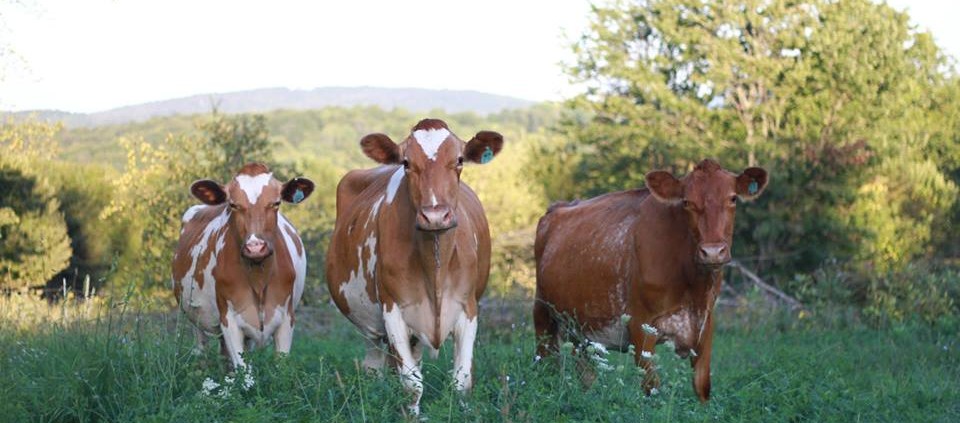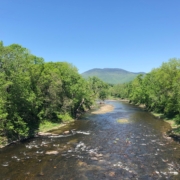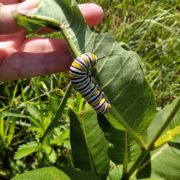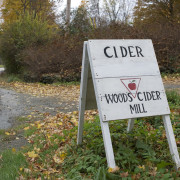Celebrating Dairy Month
Did you know that June is Dairy Month?
Here in the Upper Valley, we have many dairy farms — some with just a few cows, like On the River Farm in Lyme, and others with hundreds, like Tullando Farm in Orford. Herds here tend to be smaller than the more extensive commercial operations found elsewhere in the Twin States: in 2019, Upper Valley farms averaged of 86 cows per herd, compared to the Vermont average of 170. Today, most of the farms in our area use UVLT-conserved land to graze their Jersey, Guernsey, and Holstein cows (and some goats!) or to grow feed.
We’ve rounded up some fun facts about dairy farming that you may not know to celebrate these farmers and their herds.
1. There’s More than One Way to Measure the Value of Milk
When you buy milk at the store, it comes in pints or gallons. But did you know that dairy farmers measure their overall production in pounds? That’s because it’s too difficult to add different small quantities of volume together — weight provides a simple, straightforward solution. Wondering how much milk weighs? A gallon of milk that you might buy at the supermarket weighs 8.6 pounds,
However, when it comes to milk pricing, the calculations don’t stop with weight. The federal government sets complex standards for milk pricing, and one critical factor in the price a farmer receives for their milk is the percentage of buttermilk it contains. Generally speaking, the higher the percentage of butterfat (which is critical for making cheese, butter, ice cream, and more), the higher the price.
Because there’s so much demand for butterfat, farmers work hard to optimize for it in the milk supply. In recent years, many have sought out cow breeds known for producing higher-fat milk (like Jersey cows), bred cows carefully to improve their genetics, and experimented with different types of feed to help improve the quality of their milk. As a result, the nutrients in the nation’s milk supply — including protein as well as fat — have increased over time.
2. Feeding Cows Is an Art — and a Science
To produce high-quality milk, cows need a nutritious diet — and modern herds rarely get everything they need from grass alone.
At most dairy farms, cows actively being milked are kept near the barns that hold the milking equipment and refrigerated storage tanks. That means they tend to graze down grass in the area quickly. These cows also need more nutrients and higher-quality feed to support milk production. “Dry” cows in the stage of their lactation cycles when they do not produce milk, on the other hand, are typically found in pastures eating grass in the warmer months. Tullando Farm pastures some of its dry cows at UVLT’s Mountain View Farm Conservation Area.
While Upper Valley herds enjoy plenty of high-quality grass in the spring and summer, dairy farmers also rely on hay, hay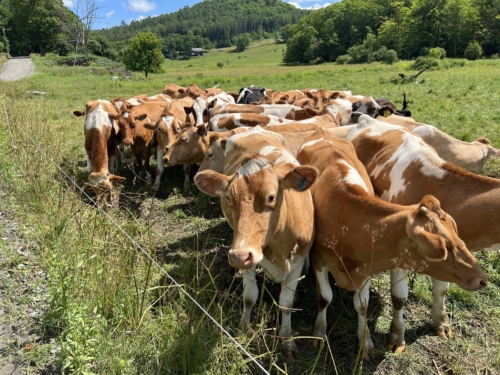 silage (grasses that are cut and fermented instead of cut and dried), and corn silage. Hay silage is more nutrient-dense than hay, and corn silage is more nutrient-dense than hay silage. Many farms also supplement with grain or corn concentrates. Dairies that are entirely “grass-fed” do not feed corn products, including silage. Ultimately, each farmer uses their judgment, experience, and knowledge of their herd to find the best fit for their cows and their land.
silage (grasses that are cut and fermented instead of cut and dried), and corn silage. Hay silage is more nutrient-dense than hay, and corn silage is more nutrient-dense than hay silage. Many farms also supplement with grain or corn concentrates. Dairies that are entirely “grass-fed” do not feed corn products, including silage. Ultimately, each farmer uses their judgment, experience, and knowledge of their herd to find the best fit for their cows and their land.
Many farmers grow their own animal feed, often on riverbottom land. To get the best harvests and the most nutritious animal feed, they use practices like planting cover crops and buffers and rotating their crops. Here in the Upper Valley, LeClair Acres Farm in Claremont grows hay and corn for its dairy herd at Up on the Hill Conservation Area in Charlestown, Claremont, and Unity.
3. Milk’s Journey from a Local Farm to Your Fridge Can Be Complicated
Given the size of the dairy industry in New Hampshire and Vermont, you might assume that milk you buy in the Upper Valley was produced and processed locally — but it’s not always that straightforward.
The US dairy industry is highly consolidated, and for most farmers, the only viable choice is to join a large-scale dairy cooperative that aggregates milk from multiple suppliers and sells it to buyers. The three major cooperatives present in our area are Agri-Mark (based in New England), Dairy Farmers of America (the largest dairy cooperative in the country), and Organic Valley.
This aggregation makes it difficult to track where the milk we buy comes from originally — or where it ends up. Milk in our local supermarkets is primarily processed in New Hampshire, Vermont, New York, and Massachusetts, though some comes from as far away as Utah and Colorado.
Similarly, we know that milk produced on our local farms is processed in New Hampshire, Vermont, New York, and Massachusetts to be sold as milk or as products like cheese and yogurt, but we do not know where those products are ultimately sold, making it difficult to effectively “buy local.”
As of 2019, there were about 30 dairy processors in the Upper Valley, primarily concentrated nearer to the river. The vast majority of these are small-scale cheesemakers. While a few local dairies sell their own milk, on-farm bottling is expensive and challenging for most farms, so they more often use shared facilities. In our area, McNamara Dairy and Strafford Organic Creamery stand out as successful dairy producers with their own processing and bottling equipment. Both are current UVLT partners — McNamara leases conserved land to grow feed crops for their herd, and Strafford Organic Creamery owns conserved land where they pasture dry cows and grow feed.
4. Dairy Farmers Are Critical to Land Conservation
Our local dairy farmers are some of our most important partners in protecting land for future generations.
Farmers need fertile, protected land to produce their crops and feed their animals — and land conservation ensures that these resources remain available for future generations of farmers.
Setting up a conservation easement for farmland is a complex process, but it’s a win-win for the farmers and for UVLT. Farmers care deeply about their land, and selling a conservation easement is a way to protect it. The proceeds from these sales can also be a game changer for farmers, allowing them to acquire more land, capitalize new ventures, retire debt, or make ownership or management transitions — without risking development on the land. We’re proud to have successfully completed numerous farmland conservation easements and have more in the pipeline.
Next time you drive past a herd of cows grazing or drink a glass of cold milk, take a moment to think of all that our dairy farmers do for our community and for protecting the land we love!

